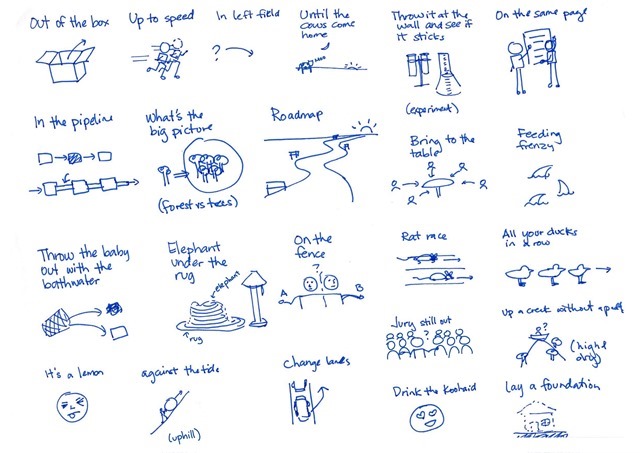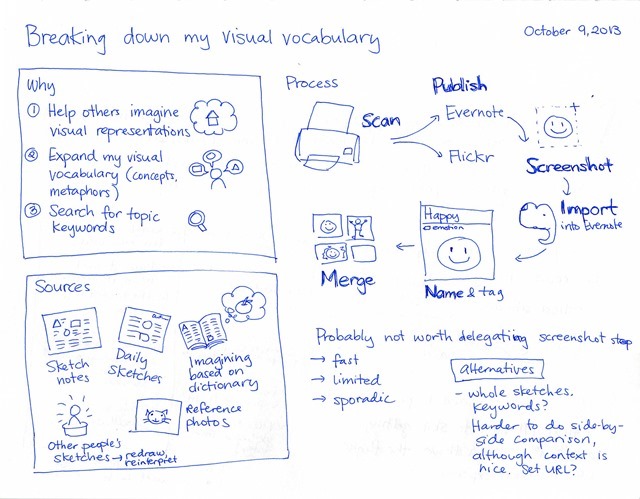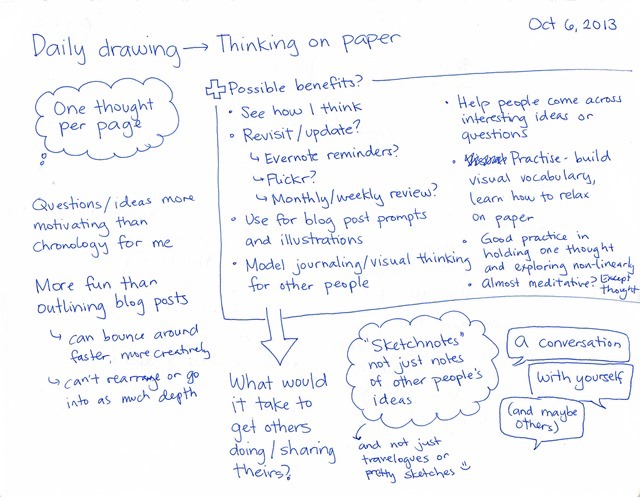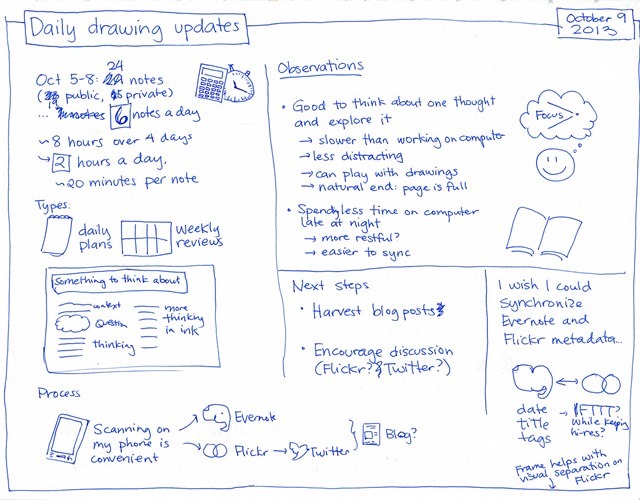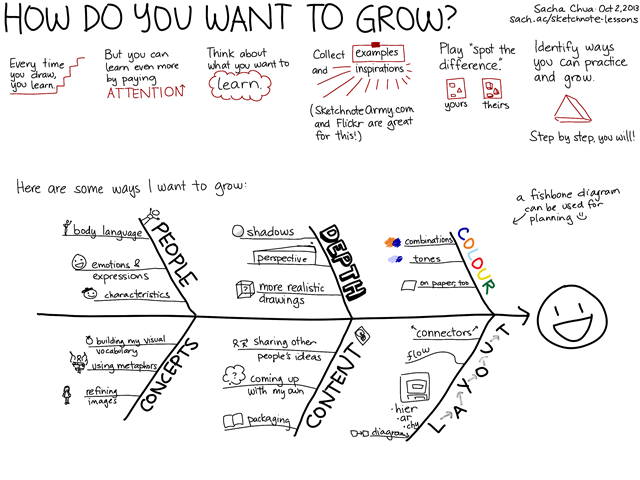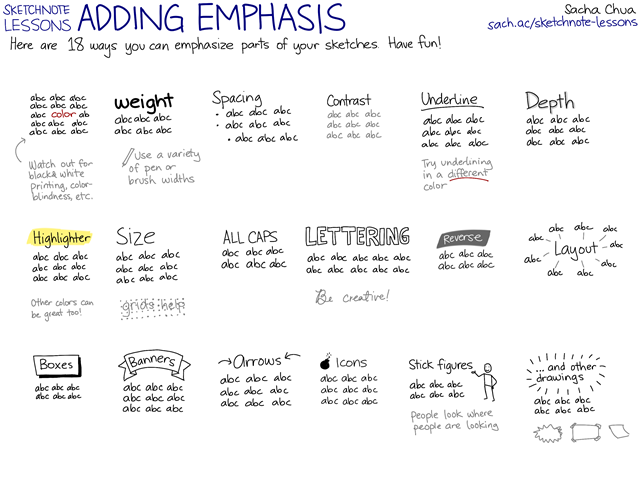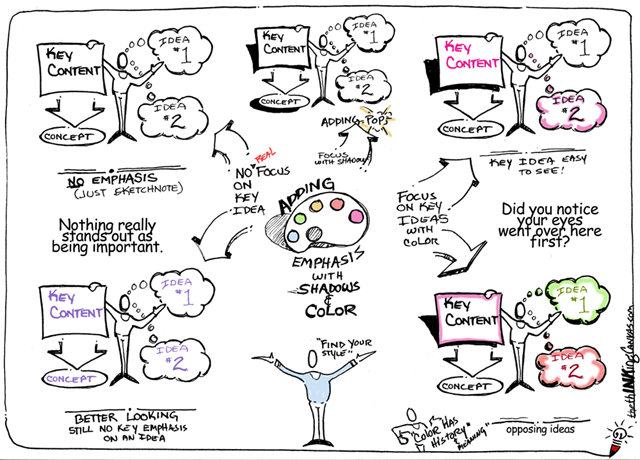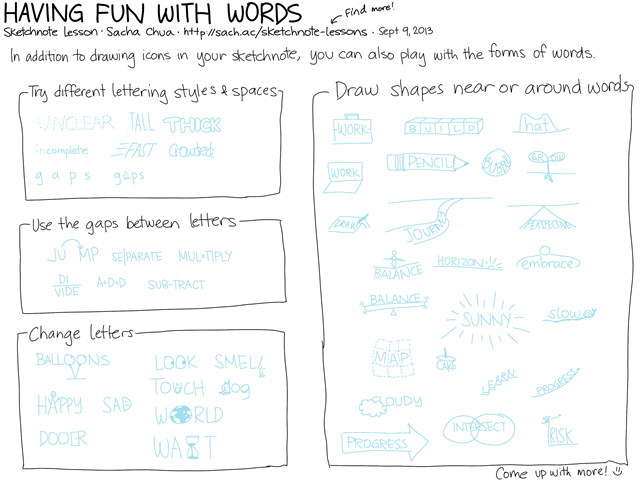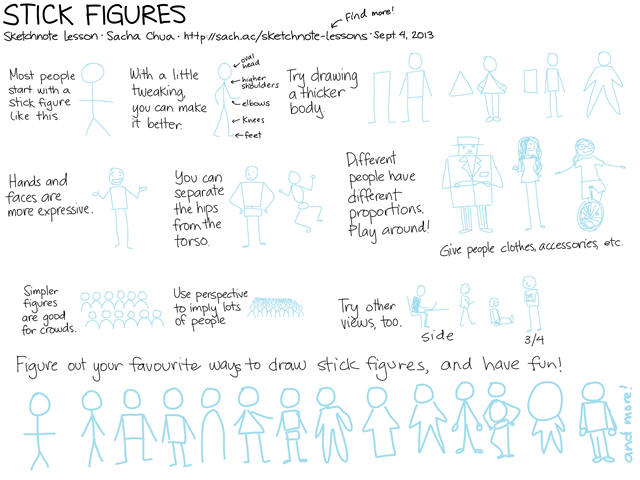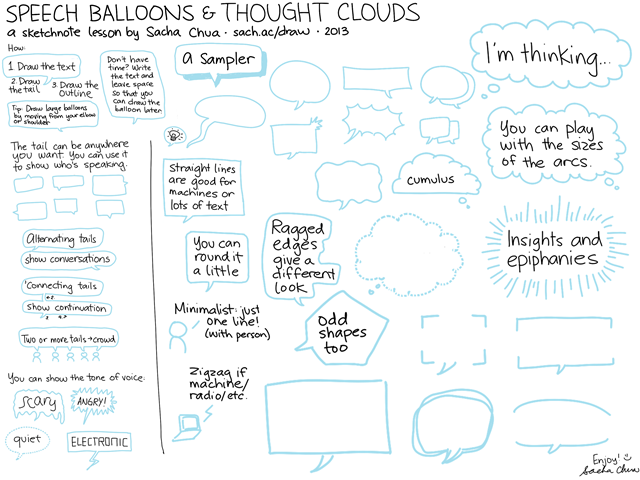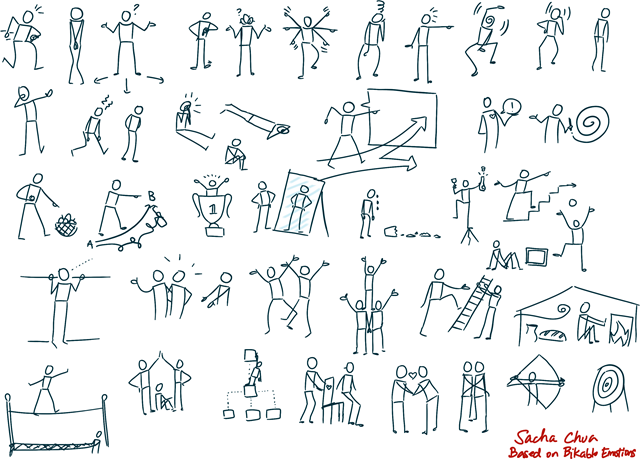Sketchnote Lessons
Want to get a notification whenever I post a new sketchnote lesson (usually Thursday mornings)? You can sign up for e-mail updates:
or subscribe to http://feeds.sachachua.com/sketchnote-lessons in your feed reader.
If you have any questions, comments, or suggestions, I’d love to hear from you. Comment on the individual items or in the comment space below. You can also e-mail me at sacha@sachachua.com.
Sketchnote Lesson: Metaphors
A fun way to build your visual vocabulary is to explore metaphors and clichés. While you should minimize the use of clichés in writing, they frequently show up in speech, and drawing them can make your sketchnotes more visually interesting.
Here’s a sampler of metaphors based on an exercise I did in the Rockstar Scribe class. Some of them didn’t resonate as much with me, so I replaced them with similar metaphors. For example, I don’t really use “against the tide” that much, so I drew a stick figure rolling a boulder up hill. If you play around with these ideas, I’m sure you can come up with even more!
The Internet has lots of collections of cliches and figures of speech. ClicheSite has a searchable index. Metaphors.com focuses just on metaphors. There are plenty of ideas to practise with – Enjoy!
Visual thinking: build your visual library
I’ve written about my process for breaking down inspiring sketchnotes and building a visual dictionary/thesaurus. Tom suggested that I put together an Evernote shared notebook where I can share examples with you. Since I can’t share my main visual library because it uses snippets of other people’s sketchnotes, I’ve been slowly building up a visual library based on my own sketches. As you’ll see, I have a very simple vocabulary! Here’s my process for building my vocabulary:
And here’s the actual library as an Evernote shared notebook. So far, it includes elements from my sketchnotes from 2013. I’m looking forward to adding more sketches from previous years and my daily sketches, and redrawing some of the more common terms I’ve seen in other people’s sketches.
This is what it looks like in Evernote:
Enjoy! I’d love to see your visual library/dictionary/thesaurus. Evernote looks like an excellent tool for creating and sharing these, and I hope you’ll put one together for yourself too. Feel free to browse through and use mine!
https://www.evernote.com/pub/sachac/vocab
Drawing practice: Daily drawing
Instead of sharing a sketchnoting tip, I thought I’d write about a new habit that I’m working on forming: drawing my thoughts every day. It turns out that this is a great way to think about stuff and practice drawing at the same time.
I find it difficult to draw a visual journal because I don’t think the everyday details of my life are all that interesting. On the other hand, I really like the way drawing helps me think through stuff. Instead of drawing what I had for lunch, then, I pick an idea or question I want to explore, and then I start writing. Sometimes I’ll add little sketchnote-y doodles. Sometimes the page is full of text. I always end up learning a little more or having a clearer understanding, so it all works out.
The sketchnotes are more fun to create and easier to share than writing text notes or making simple mindmaps. They’re also easier to review. I scan my sketchnotes every day and import them into Evernote and Flickr, and I’ve flipped through my digital copies a few times already.
I fill way more pages when I use drawing as a tool for thinking instead of just as a tool for recording other people’s thoughts. I’ve been averaging 6 notes a day at about 20 minutes a note, and I consider it time well spent. As I get the hang of doing this, maybe my notes will be more creative and more elaborate. We’ll see!
Don’t limit sketchnoting to drawing other people’s thoughts or save it only for brainstorming on special occasions. Use it every day as a tool for helping you think! =)
Here are some things I’ve been thinking about:
I’ve also been drawing my daily plans (08-Oct-13, 07-Oct-13, 06-Oct-13) and weekly reviews.
Do you sketch your thoughts? Try making it a daily habit!
Sketchnote Lessons: How do you want to grow as a sketchnoter?
It’s good to think about how you want to grow, collect examples, break down those goals into specific skills you can work on, and practise. You can see how I’ve been practising and sharing different skills in my sketchnote lessons. =) Focusing on one skill at a time makes it easier to try different variations and learn more.
By the way, if you would like to practise by making your own sketchnote lessons, please feel free to share your work with me and I can link to it or repost it in this series.
Enjoy!
Sketchnote Lessons: Adding Emphasis
If you emphasize parts of your sketches, you make it easier to review and “read.”
Color, weight, spacing, contrast, underline, depth, highlighter, size, all caps, lettering, reverse, layout, boxes, banners, arrows, icons, stick figures, and other drawings… Have fun!
Like this? Check out the other sketchnote lessons and learn more. Feel free to suggest topics, ask questions, or share your own tips!
Sketchnote Lesson: Adding color
Color is a great way to add visual interest and guide people’s eyes to what you want them to focus on. Here’s Kevin Dulle’s sketchnote lesson on adding emphasis with shadows and color:
Reposted with permission – check out his blog for more tips!
If you’re starting out with sketchnotes, you don’t have to use color right away. Go ahead and draw with whatever you feel comfortable with, whether that’s a black technical pen, a 4-color ballpen, or a digital stylus.
You can always add color afterwards. On paper, you can use crayons, colored pencils, highlighters, markers, and so on. Make sure you test it in an inconspicuous area (maybe on a separate piece of paper) because your coloring method may interact badly with your drawing.
You can also add color on the computer. I prefer this way because then I can easily change my mind about what colors to use. Erasing is easier. Learn how to use the software tools that are out there. Here is a quick video I put together on how to use the free GIMP tool to add color by either replacing the ink that’s there (as if you changed pens) or adding color on top (as if you used a highlighter).
Okay, so that takes care of the mechanics. What about the styles?
Develop your personal style by looking for inspiration and experimenting with ideas. In addition to checking out people’s sketchnotes, look elsewhere for interesting color combinations: nature, art, product designs, and so on. Try different techniques and colors.
Here’s a sampler of different coloring styles I’ve played with in my sketchnotes:
 |
Highlighter I like this because it’s super-easy to add quickly if you’re drawing digitally – just add a new layer below your text. Visual Book Review: The First 20 Hours: How to Learn Anything… Fast |
 |
Color as accent for images You can add this while drawing by switching between pens (on paper) or between colors (if digital), or you can use the Color layer trick in the video to add it afterwards. How to use Evernote to improve your visual thinking |
 |
Colors with meanings Here I used red to indicate the path of my mistakes and blue to indicate what I could improve. An embarrassing failure is the result of a series of unfortunate decisions, and that’s a good thing. |
 |
Emphasis Red is a great color for drawing attention. Coloring your headlines helps set them apart. Visual Book Review: Running Lean – Ash Maurya |
 |
Extra information You can also use gray or lighter colours to include extra information that people don’t need to focus on. Visual Book Review: The Start-Up of You – Reid Hoffman, Ben Casnocha |
 |
Depth You can use a lighter colour for shading or depth. Visual Book Review: The Sketchnote Handbook |
 |
Branding Pick up colors from company logos or event materials to make your sketchnotes look more like part of the event. Sketchnotes: #INNOTalkTO Innovatively Speaking |
 |
Lots of colors This is fun to do when you have more time. In this case, I colored in my sketchnote while waiting in line for an “autograph.” Sketchnotes: How to Live an Amazing Life – C.C.Chapman |
Sketchnote Army has a wide variety of sketchnoting styles. Flip through it, see what you like, and try playing around with those ideas. Have fun!
Like this? Check out the other sketchnote lessons and learn more. Feel free to suggest topics, ask questions, or share your own tips!
Sketchnote Lessons: Having fun with words
In addition to drawing icons, you can also play with the forms of words in order to make them more fun or visually interesting. Here are some examples. Click on the image to view or download a larger version that you can trace or doodle on, and feel free to share this with others. (Creative Commons Attribution License)
See http://sach.ac/sketchnote-lessons for the other tips in this series, and check back next Thursday for more!
Sketchnote lessons: Stick figures
Stick figures are fun to draw. Click on the image to view or download a larger version that you can trace or doodle on, and feel free to share this with others! (Creative Commons Attribution License)
See http://sach.ac/sketchnote-lessons for the other tips in this series, and check back next Thursday for more!
Sketchnote Lessons: Speech bubbles and thought clouds
Here’s an assortment of speech bubbles and thought clouds. They’re great for indicating when someone has said something – and there’s always plenty of talking at presentations, panels, and events.
Click on the image for a larger version. Feel free to print this out (or draw on it on your tablet, if you have one)! =)
Have fun drawing! Check out my other sketchnote lessons, and e-mail or comment if you have any suggestions/requests!
Sketchnote Lessons: Arrows and Connectors
You can use use arrows or connectors to guide people through your sketchnote/drawing. Here are some samples:
For more drawing tips, check out the other sketchnote lessons!
Sketchnote Lessons: Quick Lettering
Here are some examples of different lettering styles that you can try. Some of them (like Chisel or Reverse) may be easier to do digitally than on paper. Click on the image to view or download a larger version, and have fun practicising. Enjoy!
I write in print instead of cursive because this is easier to read. Computers seem to be better at understanding printed letters instead of cursive. (I use Evernote to search my notes.) For emphasis, I sometimes use Multiple (draw the same letter twice), or Bold if I can anticipate the need to switch pens.
Got any favourite quick lettering techniques? I’d love to see them! Post links below, or e-mail me at sacha@sachachua.com .
Sketchnote Lessons: Banners and ribbons
Banners and ribbons are a quick way to emphasize parts of your drawing. Instead of drawing the banner and then trying to fit the text into it, try drawing the text first and then drawing the banner around it. Here’s a step-by-step example.
1. Draw the text with plenty of space around it
2. Draw a box around the text.
3. Add two small triangles below the box.
4. Draw horizontal lines extending beyond the triangle, and another set of lines the same distance from the top of the box.
5. Add a ribbon edge if you want, or use a straight line.
Want to get fancy? Add some shading, add more folds, and so on.
Here are some examples that you can practise with:
Check out Kevin Dulle’s tutorial for other ways to emphasize things with shadows. Enjoy!
Sketchnote Lessons: Drawing Emotions
Want to make your drawings more interesting? Add emotions! Drawings of emotions can communicate so much more than words describing emotions, and they do so in an immediate, visceral way. For example, consider the list of words below, and the faces beneath them.
Even if you don’t think you’re an artist, you can draw basic emotions easily. Simple combinations of eyebrows and mouths say a lot. You can show different degrees of emotions by emphasizing parts.
You can combine emotions, too. For example, angry eyebrows + happy smile = evil overlord plotting to conquer the world. >=)
Play around, and you’ll find even more emotions that you can express with small changes to the face. For inspiration, you can look at smileys and emoticons.
Icons and symbols let you be even more expressive. You can pick these up from comics and smileys.
Emotions aren’t just expressed with the face. Posture can communicate emotions powerfully too. Explore the physicality of emotions by looking at how actors show feelings, or by imagining yourself feeling those emotions.
You can also show emotions in how people relate to each other.
Metaphors are fun to play with, too.
Learning how to draw emotions isn’t just useful for sketchnoting. You can draw emotions in order to understand other people better. Mindmaps or empathy maps can help. You can draw your own emotions, too. When I’m faced with a difficult situation or a confusing tangle of emotions, I try to break down the different emotions I feel and the reasons why I feel that way. When you understand why you’re happy and sad and worried and excited all at the same time, it’s easier to move forward.
Want to learn more about drawing emotions? The best resource I’ve found so far is the Bikablo Emotions book, which has a lot of full-body emotions. Here’s a sample of the drawings I made based on part of the Bikablo Emotions book. (There are even more emotions in the book – check it out!)
Children’s books are a good source of emotions. I remember loving the Mr. Men and Little Miss series when I was growing up, and I look forward to discovering other wonderful illustrations as I go through the library’s collections. =)
Comics are another great way to learn more about expressing emotions, from the concise forms of newspaper strips to more elaborate drawings in comic books.
And then there’s learning about all these emotions in the first place, because it helps to be able to recognize the emotion and give it a name. Wikipedia has a few good pages: Contrasting and categorization of emotions, Emotion classification. HUMAINE proposes a classification of 48 emotions (see Wikipedia for an easier-to-read list) The Center for Nonviolent Communication lists 259 emotions in their feelings inventory.
I’m thinking of going through those lists and practising drawing all these different emotions. Want to join me? I’ll post stuff here once in a while, and I’d love it if you sent me links to your drawings!

